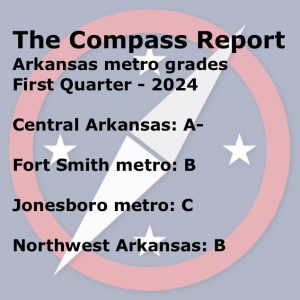The Compass Report: Job data shows mixed results, but overall economy healthy
by June 17, 2024 11:57 am 565 views

Overall job growth in Arkansas was “robust” in the first quarter of 2024, but a rise in the number of unemployed and manufacturing job losses indicates a resilient economy with areas needing attention to sustain growth, according to The Compass Report.
The Compass Report is a partnership between the University of Arkansas at Fort Smith (UAFS) and Talk Business & Politics. First National Bank of Fort Smith is a sponsor of the statewide report.
Kendall Ross, UAFS associate vice chancellor of Economic and Workforce Development, and Troy Rodriguez, a data analyst in the UAFS Center for Economic Development who helps compile, manage and review the data, are responsible for data collection and written analysis for the report.
The report measures four leading and four current economic indicators to provide a grade for a regional economy. The eight categories measured to determine The Compass Report grade in the Central Arkansas, Fort Smith and Northwest Arkansas areas are total nonfarm jobs, unemployment rate, building permits, sales tax revenue, manufacturing jobs, service sector jobs, construction jobs, tourism jobs and concentration of manufacturing jobs. Because the data is not available, construction and tourism jobs are not included in the Jonesboro metro grade.
In the first quarter 2024 report, Central Arkansas received an “A-” grade, the Fort Smith metro had a “B” grade, the Jonesboro area received a “C” grade, and Northwest Arkansas had a “B” grade.

MIXED RESULTS
During the first quarter of 2024, Arkansas exhibited robust growth in non-farm employment, consistently expanding throughout the period. From January 2023 to March 2024, the state experienced an increase of 14,000 jobs, reflecting a 1% rise. By March 2024, non-farm employment reached an estimated total of 1,367,000 positions, up from 1,352,000 in March 2023. This trend suggests a strong and stable job market, earning an A+ grade for non-farm employment.

In summary, economic conditions in Arkansas for the first quarter of 2024 highlight strengths and weaknesses. The state displayed significant increases in non-farm employment and notable growth in the construction and hospitality sectors. However, the rise in the unemployment rate and declines in manufacturing employment indicate potential challenges.
The Compass report also showed impressive growth in the state’s construction sector.
TOP TAKEAWAYS
Following are some of the key takeaways from Ross and Rodriguez included in The Compass Report.

Central Arkansas
The regional economy is bolstered by significant job growth and strong performance in the housing market. However, the rise in the unemployment rate and mixed tax collection results highlight areas that require ongoing monitoring and strategic planning to ensure sustained economic health.
Northwest Arkansas
Overall, the economic outlook for Northwest Arkansas in Q1 2024 remains positive, supported by continued growth in construction and hospitality sectors, robust tax collections, and overall resilience. However, challenges in sectors such as manufacturing require ongoing monitoring and targeted strategies to ensure sustained long-term economic prosperity.
Fort Smith metro
Overall, the Fort Smith region demonstrated economic stability and potential for growth in Q1 2024. Despite fluctuations in certain sectors and declines in tax collections, the region’s employment growth and improving unemployment rate indicate resilience and a positive trajectory for future economic development.
Jonesboro metro
Despite challenges in the labor market, the Jonesboro metro demonstrates stability and potential for growth in housing and construction sectors, as well as in tax collections. However, the increase in the unemployment rate and decline in non-farm employment underscore the need for targeted strategies to address labor market dynamics and stimulate economic activity.
DATA AND MORE ANALYSIS
Link here for the first quarter 2024 raw data gathered by the University of Arkansas at Fort Smith Center for Economic Development.
Link here for the quarterly narrative.
Also, link here for the all the previous reports.
